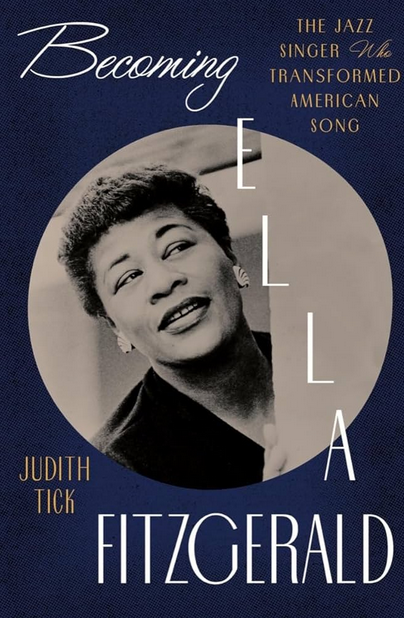Becoming Ella Fitzgerald: The Jazz Singer Who Transformed American Song
- By Judith Tick
- W.W. Norton & Company
- 560 pp.
- Reviewed by Rose Rankin
- January 4, 2024
An exhaustive, unsatisfying look at one of the 20th century’s premier performers.

The telling of a history — whether of an event, a time period, or a life story — involves recounting the basics of who, what, where, and so on. It also calls for explaining the why — why something was different than what came before, or why it came to be so important. On the first account, Judith Tick’s new biography, Becoming Ella Fitzgerald, succeeds admirably. On the second, however, it unfortunately falls short.
Tick digs deep into archival research to painstakingly reconstruct Fitzgerald’s life, starting with her upbringing in segregated Yonkers, New York. Musically inclined from a young age and encouraged by her mother, Fitzgerald initially wanted to be a dancer, but her singing brought her more gigs during her Depression-era teenage years.
After a harrowing stay at a girls’ juvenile-detention facility — for a minor truancy infraction compounded by overzealous sentencing, an all-too-familiar situation for Black youth — Fitzgerald got her first break at the Apollo Theater’s Amateur Hour in 1934. Her nerves almost got her booed off the stage, but thanks to a kind emcee giving her a second chance that night, she ended up electrifying the audience.
Tick’s thorough research in Black press materials, which covered Fitzgerald’s early career more fully than mainstream papers, gives her account a deep level of detail and firsthand stories. It’s engaging context that brings to life the vibrant world of 1930s swing music, but the focus on minutiae crowds out analysis.
Fitzgerald wasn’t a sex symbol or a stunning beauty, and jazz singers at the time were second class compared to musicians in general. Yet she overcame the resistance of her first bandleader, Chick Webb, to including a female singer and eventually became his swing band’s major draw thanks to her prodigious talent. But with hits like “A-Tisket, A-Tasket,” she was depicted as an innocent schoolgirl, as opposed to her contemporary Billie Holliday, who was sultry and sexually alluring.
Tick carefully documents how Fitzgerald’s looks and weight affected her image, but she stops short of asking why “schoolgirl” or “sexpot” were the only options for Fitzgerald’s public persona, or exploring what role white male managers might’ve played in pigeonholing her. She doesn’t shy away from acknowledging the entrenched racism Fitzgerald and other Black musicians faced, nor does she ignore the intersection of racism and misogyny directed toward female singers. That’s what makes her surface-level descriptions of Fitzgerald’s early persona so odd. They leave the reader wanting more.
After Webb’s untimely death in 1939, Fitzgerald became not just a singer but a bandleader. Despite contemporaneous criticism, she explored new forms of jazz, moving from swing to bebop, an early demonstration of her commitment to pushing musical boundaries. Her nonstop touring and recording schedule through the 1940s and 50s is recounted in granular detail — often too granular, becoming a catalog of every setlist, every show, and every tour.
But trends do emerge: Fitzgerald’s collaborations with the biggest names in jazz; her remarkable ability to reinvent herself musically; and the persistent tension between her wanting a home and family alongside her near obsession with performing.
For example, Tick chronicles Fitzgerald’s work with jazz luminaries like Dizzy Gillespie, Duke Ellington, and Louis Armstrong. By the 1960s, she added pop and rock numbers to her sets, going so far as to cover the Beatles and Cream. When critics complained, she retorted that young listeners wanted to hear those songs. “It’s a drag if you don’t have anything to offer them,” she explained.
By the 1960s, Fitzgerald had reached commercial and critical acclaim anyway, thanks to her renditions of the “songbooks” of major American composers such as Ellington, Cole Porter, and Irving Berlin. This music would go on to form the foundation of the Great American Songbook, cementing Fitzgerald’s rightful place in entertainment history.
Her later decades were wracked by health problems and a stubborn refusal to reduce her touring schedule. She remained a quiet though steady supporter of civil-rights initiatives during the 1960s and 70s, and by the 1980s, she was widely recognized as a member of the American musical pantheon.
Perhaps Tick’s biography provides as intimate a look as possible into the life of a staunchly private celebrity, yet the litany of setlists and performances in its pages supplants what could’ve been deeper explorations of the icon. Why did Fitzgerald choose audience over companions at nearly every turn? Why was her constant boundary-breaking vis-à-vis musical choices upsetting to so many critics? It’s a shame that a music historian of Tick’s abilities leaves these questions unanswered. Ultimately, Becoming Ella Fitzgerald is a valuable work of scholarship, but like its enigmatic subject, it leaves the reader wondering what’s beneath the surface.
Rose Rankin is a freelance writer from Chicago. She focuses on history, science, and gender issues, in particular women’s literary history.
_80_112.png)
